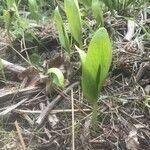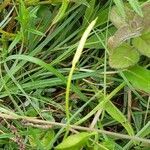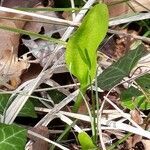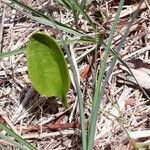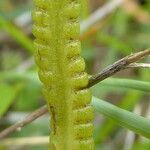Plants 10-30 cm tall. Rhizomes erect, bearing a cluster of fleshy roots; roots extending horizontally and stolonlike. Fronds usually single; common stalk pale at lower part, 6-9 cm, slightly robust, deeply buried underground. Sterile lamina sessile, elliptic or narrowly ovate, rarely ovate, 6-10 × 1.5-4 cm, slightly fleshy to herbaceous, base cuneate, truncate, or rounded, sometimes abruptly narrowed, margin entire, apex obtuse or abruptly acute; veins distinctly reticulate. Sporophore arising from base of sterile lamina, 9-18 cm or longer; spike 2.5-3.5 cm, ca. 0.2 mm in diam., apex acute, exceeding sterile lamina. Spore surface obviously and coarsely reticulate. 2n = 240-1140.
Plants 7–35 cm; stipe (1.5–)6–13(–19) cm; lvs mostly solitary; blade flat, elliptic-oblong to ovate, rounded to obtuse or subacute, but not apiculate, mostly 4–8 × (1–)2–4 cm, sessile or short-stalked; venation regularly areolate, the areoles all small with mostly free included veinlets, not enclosing secondary areoles; sporophore 1–5 cm × 2.5–4 mm on a stalk mostly 7–14 cm; sporangia 0.6–1.2 mm thick; 2n=960–1320. Circumboreal, in Amer. from N.S. to Wash., s. to Fla. and Tex. Two vars. with us.
Rhizome fusiform, up to 25 mm long, up to 3 mm in diam.; roots with proliferous buds. Leaves mostly 1. Stipe up to 125 mm long, 25-30% of its length subterranean, stipe bases not persistent. Lamina midgreen, sterile and fertile lamina held at 60-80° from ground, sterile lamina broadly ovate, usually partly folded, up to 50 x 22 mm, apex acute to apiculate, base narrowly to broadly cuneate. Fertile spike up to 70 mm long, with up to 35 sporangia pairs, apiculate.
Rhizome cylindrical, 3-4 mm in diameter. Fronds usually 1, rarely 3; stipe subterranean for less than Ai its length, 40-180 mm long; stipe bases not persistent; sterile lamina ovate-oblong, acute, c. 70 x 30 mm, mucronate, base cuneate; venation obscure or apparent; fertile spike inserted at base of sterile lamina or just below apparent base, up to 180 mm long, with up to 36 pairs of sporangia, apiculus subulate, attenuate, c. 1-2 mm long.
Rhizome cylindrical, 3-4 mm in diameter. Old stipe bases not persistent. Base of sterile lamina cuneate; venation apparent to obscure. Sterile lamina broader than 12 mm.
A fern. It has a short underground stem or rhizome. There is usually only one leaf.
